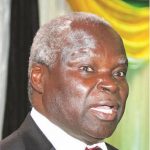1998 – Riots hit the country in January after the price of basic goods rises by up to 50 percent, blamed on the collapse of the Zimdollar. Maize meal prices rise by 45 percent within a week.
Army is deployed into the streets for the first time in years to quell the riots. “They will not hesitate to shoot,” Home Affairs Minister Dumiso Dabengwa warns. At least eight people are left dead in the clampdown.
Government introduces price controls and a range of tariffs on imports.
In August, Zimbabwe enters the DRC war. Some estimates say the country is spending US$1m a day to fund the war, further weakening the local currency.
1999 – Running out of forex, Zimbabwe has defaulted on most of its foreign debt by mid-year. The IMF finally confirms its intention to withdraw funding. This leads to further exchange controls. The Government fixes the Zimdollar rate at $38 to USD in 1999, way above its true value.
2000 – Murerwa is reshuffled out. On August 1, new finance minister, Simba Makoni, bows to market pressure and devalues the Zimdollar to $55 to the US dollar, still lower than the parallel market rate of $60 for a US dollar. In the same week, unions, businesses and activists stage a nationwide stay away to protest the economic crisis.
2001 — A $500 note is issued, and is followed by another different $500 note within weeks. A $5 coin is also introduced.
2002 – Mugabe rejects Makoni’s pleas for further devaluation. “Devaluation is sinister and can only be advocated for by our saboteurs and enemies of this government,” Mugabe tells him. Makoni is soon fired, and Murerwa is reappointed.
Government shuts down all bureaux de change, accusing them of being “conduits” for illegal forex trade.
In June, the IMF suspends technical assistance because of arrears amounting to US$132 million.
2003 – The RBZ introduces what it calls traveller’s cheques, in denominations of $1 000, $5 000, $10 000, $20 000, $50 000 to $100 000. They are hugely unpopular and are soon quietly phased out.
Zimbabwe is now producing less than half its 1996 exports. Pressure is building.
That September, RBZ introduces bearer cheques in denominations of $5 000, $10 000 and $20 000. Initially, the bearer cheques are only valid up to January 31, 2004.
Zimbabwe’s reserves are down to under US$20 million, about 3 days’ worth of imports cover then.
In November, the IMF begins compulsory withdrawal procedures for Zimbabwe; IMF-speak of kicking Zimbabwe out.
In December 2003, Gideon Gono is appointed governor. It is a decision that is to have a major impact on the future of the currency. Later, a leaked US embassy cable was to quote IMF mission chief Sharmini Coorey describing Gono as “the world’s worst central banker by far.”
One of Gono’s first decisions is to tighten control of central bank’s accommodation of banks. This leaves many banks in crisis.
Continued next page
(718 VIEWS)


